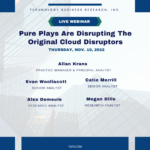Intentionality and industry clouds: How EY’s Microsoft practice harnessed a dynamic market
- EY has transformed from a legacy audit, tax, and consulting firm into a technology-enhanced digital transformation powerhouse. Its Microsoft practice currently ranks as the 4th largest Microsoft Dynamics 365 partner globally.
- Its strategy aligns with two dominant trends in digital transformation: industry clouds and multi-enterprise business networks. Its all-of-the-ecosystem strategy aligns with digital transformation clients’ understanding that no vendor is a one-stop-shop.
- EY is committed to bespoke, higher-value, innovative cloud professional services while leaving the commoditized work to global systems integrators, and it is well positioned to continue growing its Microsoft practice with Infosys as a potential partner for Microsoft-specific consulting opportunities.
It starts with context
EY’s robust and expanding Microsoft (Nasdaq: MSFT) practice exemplifies how steadily, quietly and persistently EY has transformed from a legacy audit, tax and consulting firm into a technology-enhanced digital transformation powerhouse. While media and competitor attention focuses on EY’s pending split into a legacy audit firm and an unfettered consulting and IT services vendor, the existing firm continues acquiring assets and talent, growing revenues, and delivering to clients and technology partners.
In October TBR met with leaders from EY’s Microsoft practice, including Jim Little, EY Global Microsoft Alliance leader. We discussed trends across the cloud and IT services ecosystem, EY’s Microsoft-related capabilities and growth, and EY’s expectations for 2023 and beyond. The following reflects that conversation and TBR’s ongoing research on EY, Microsoft, and both vendors’ ecosystems and competitive landscapes.
Building capabilities and influence by playing to strengths
EY continues to build, run and sell consulting services, including a Microsoft practice that Little and his team said currently ranks as the fourth-largest Microsoft Dynamics 365 partner globally. Among the facts and figures EY presented, a few stood out to TBR:
- EY earned over 6,000 Microsoft certifications in FY22 and is an Advanced Specialized partner with Microsoft Solution Partner designation across all six domains.
- Ninety percent of EY client service solutions are used on the Azure cloud.
- EY has delivered over 16,000 Microsoft projects across over 4,000 clients globally.
Greg Jenko, EY Global Microsoft Services Group leader, noted that EY is a “business transformation firm” with well-established industry expertise and a long history of understanding back-office processes and change management, allowing EY to “deliver transformation on the back of Microsoft.”
While not competing with India-centric IT services vendors on cost-driven cloud migrations, EY has been building capabilities on top of the Microsoft stack, focused on six advanced specializations (in addition to broad Microsoft capabilities). EY’s U.S. member firm has a dedicated Microsoft team, while member firms in other regions with less scale operate as virtual business groups. According to EY, the firm’s global connected dedicated Microsoft Team is the first among the Big Four at its current focus and magnitude.
In addition to the firm’s size, scope and capabilities, Little also stressed EY’s flexibility, noting that his firm could examine business model and technology implications of a client’s strategy, leading to EY-assisted bespoke data-driven transformations. Kathy Hevland, EY Global Microsoft Relationship director, explained that the firm has “strong brand permission” in heavily regulated industries, such as financial services, based on EY’s heritage in audit and assurance.
Additionally, EY has found success working with clients in industries with critical supply chain challenges. Little summed up EY’s value in the Microsoft space by noting that “bringing EY specialists to bear allows clients to move faster,” which echoes TBR’s research around clients’ highest priorities for digital transformations and cloud migrations.
Shaping trends around industry clouds and ecosystem alliances
Looking ahead, the EY team’s comments about strategy and opportunities matched two dominant trends in digital transformation: industry clouds (aka smarter alliances) and multi-enterprise business networks (aka extended ecosystem plays). Little said EY has been partnering with Microsoft in “engineering solutions to ensure industry clouds are fit for purpose” at both the sector and subsector levels.
Further refining EY’s strategy, Little added that the firm has focused subsector industry cloud innovations on geographies where EY and Microsoft have already been jointly partnering to deliver to clients. EY has played to its own strengths, by both industry and geography, to maximize the benefits of its Microsoft capabilities (in contrast to peers and larger IT services vendors, which have remained more opportunistic and transactional). According to Little’s description, EY is also influencing Microsoft’s strategic road map for industry clouds. In TBR’s view, the hyperscalers’ increased push into industry clouds will both expose the ecosystem players lacking industry expertise and open opportunities for vendors (and especially consultancies) with established industry-centric capabilities.
In that evolving cloud and digital transformation ecosystem, EY’s strategic decision to stay committed to bespoke, higher-value, innovative cloud professional services, while leaving the commoditized “simple stuff” to the global systems integrators, further plays to the firm’s strengths and helps maintain the firm’s brand permission around business transformation enabled by technology. Further, Hevland noted that “80% of EY’s ecosystem partners” are also Microsoft’s partners, reflecting Microsoft’s “incredibly ecosystem-friendly” posture.
With a strategic technology partner committed to alliance relationships and well aligned to EY’s ecosystem, EY should be well positioned to continue rapidly growing its Microsoft practice, even as it leans on IT services partners for capabilities or headcount in areas where EY lacks scale. Little suggested that Infosys, in particular, could bring Microsoft-specific consulting opportunities to EY, and Hevland noted that EY considers ecosystems critical to the firm’s strategy, including evolving new alliances with nontraditional players such as smaller, independent software vendors. In TBR’s view, EY’s all-of-the-ecosystem strategy aligns with digital transformation clients’ understanding that no vendor is truly end to end and every vendor needs to play well in the consulting, cloud and IT services sandbox.
Reassuring talent stays focused to increase retention and aid recruiting
No discussion about digital transformation can ignore talent management, which TBR and the EY team explored at length. In a stark rebuke of consultancies’ decades-long insistence that they are technology-agnostic and rely solely on their clients’ technology preferences, EY stated that while they can still be technology agnostic, they believe Microsoft is clearly winning in the market and so EY has strategically chosen to align with Microsoft and consistently reinforces that dedication. Little said EY professionals know they “will be excellent at Microsoft” and will not be “bouncing around” between hyperscalers’ technologies, giving those professionals reassurances around maximizing their skills.
In recent years, EY has acquired Microsoft-only people, niche vendors, building capabilities breadth and extending into new geographies while continuing to recruit with a sustained pitch around Microsoft-focused training and development. Sarah Bingham, EY Global Microsoft Services Group Operations leader, explained that to facilitate recruitment and training at scale, the firm developed a “recruitment-in-a-box” tool kit for EY member firms in countries with smaller, less-developed Microsoft practices. Bingham stressed that intentionality, scale and integration of Microsoft into broader EY training underpinned the global firm’s overall talent strategy. Potentially separating EY from peers, according to Bingham and Little, was the firm’s decision to focus on six advanced specializations, reinforcing EY’s role in bringing higher value to cloud migrations and optimizations.
Intentionality as a mindset for transforming challenges into opportunities
Throughout the discussion with Little and his team and upon reflecting on EY’s potentially highly disruptive change within the digital transformation landscape, the word “intentionality” stood out as succinctly encapsulating what EY has been doing with its Microsoft practice for the last few years and the challenge the firm has created for peers and competitors.
By concentrating on Microsoft Azure as a preferred cloud partner — whether by default or design — EY has wrangled three challenges and turned them into opportunities for growth. First, EY’s clients and ecosystem partners know EY’s strengths center on Microsoft technologies, diminishing any market confusion about EY’s core strategy and capabilities. Second, marrying EY’s established industry expertise with Microsoft’s emerging industry clouds provides differentiation in a crowded competitive landscape. Third, EY’s sustained focus on Microsoft gives its professionals additional reasons to stay with the firm, reducing attrition and potentially attracting highly skilled talent.
Whether or not the split happens, EY will need to sustain this intentionality and capitalize on these opportunities for growth. According to TBR’s 2Q22 Cloud Ecosystem Market Landscape, Deloitte — despite its audit relationship with Microsoft that precludes a formal go-to-market alliance — has at least 8,500 Microsoft certifications, surpassing EY’s 6,000. TBR does not expect EY to surpass Accenture’s (NYSE: ACN) 43,000 Azure certifications in the near term (or ever), but EY should be able to match and exceed Deloitte within a couple of years, provided that activities related to the potential split do not adversely affect the firm’s Microsoft practice and that EY can maintain the advantages embedded in its strategy.



 Technology Business Research, Inc.
Technology Business Research, Inc.